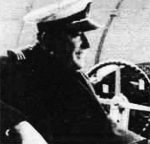A pilot remembers…
Twenty-five years ago this week Captain Arthur Wilcockson became the first man to pilot a flying-boat across the Atlantic — and pioneer of commercial aeroplane flights. Brian Inglis tells the story on Monday in All Our Yesterdays. Captain Wilcockson retired in 1959, but still retains his interest in flying as consultant to a major airline company

by Captain ARTHUR WILCOCKSON
as told to Max Wyman

RAIN lashed the Shannon River and a strong, cruel wind rocked the flying-boat as we prepared for take-off on that early July evening 25 years ago.
But the weather didn’t worry the four of us who had been chosen to crew the Caledonia on her epoch-making Transatlantic flight.
All we wanted was to be off. There had been months of preparation. Take-off and landing spaces had to be chosen. We four had to be specially trained.

The boat had to be strengthened, prepared, tested retested … and tested yet again.
The waiting had taken its toll. We were eager, impatient almost, to go.
And we couldn’t get through the formal ceremonies with the Ministers and the mayors and the Press and the officials soon enough.
It had been a trying time. But it was worth it. Because the exhilaration and relief we felt as we watched the Irish coast disappear behind us was indescribable.
We were away — doing something no one had ever done I remember thinking: “I only hope Newfoundland is where they say it is.”
The final decision to make the flight had not been taken, until the afternoon we left.
“You will have low cloud and rain for the first 500 miles,” the weather men predicted. “Then it will be clear and stay fine to Newfoundland.”
It wasn’t the weather at take-off that worried me. I just wondered how accurate they were about conditions at the other end. But I needn’t have bothered.
We took the bad weather with us for nearly 1,500 miles. We couldn’t go up because the wind was too strong, so most of the time we were flying at about 1,000 feet. And it was raining.
But by dawn we ran out of the bad weather and found ourselves flying over fog around the Grand Banks. For the rest of the trip it was like flying over the Med on a summer day.
Throughout the flight we used vessels to check our course. We had to do so — radio navigational contact with land each side ran out 250 miles from the coast.

Wc were on our own — and that meant any ships we flew over were useful for course reference. For example, we used the Empress of Britain for two or three hours, and we were jubilant. It all fitted in with our dead-reckoning navigation and we were never in doubt as to our position or course.
This was a tremendous relief for me, because we earned fuel for only 21 flying hours — so if we missed the southern tip of Newfoundland there wouldn’t be much hope.
As it was, we had reckoned on doing the flight in 15 hours — and it took 15½.
By about two in the morning we were able to take our first navigational fix from the stars — and we were bang on course. After that it was simple.
Our reception at Batwood, in Newfoundland, was fantastic. Everyone seemed to go crazy. I had expected the place to be cold, but the temperature was in the top 80’s. And in my blue uniform I just fried.

This was the first serious commercial flight across the Atlantic. And it proved that this gigantic ocean presented no problems.
If the war had not come, flying boats would dominate the air today. It was only because of the war that so many airfields were built — and airfields are so expensive that aircraft which operated from the water would, but for the war, have been the only economic method.
As it is, I feel sure that the flying-boat will come into its own for the carriage of world trade. Small countries have to build bigger and bigger air fields to accommodate aircraft they don’t operate themselves.
Suitable landing areas are more plentiful on water than on land. In my days we didn’t need much water to launch a flying boat — a mile long by 300 yards wide was enough.
After a lifetime concerned with flying-boats I was bitterly disappointed that Britain’s Princess boats never came into general use. They were marvellous craft.

But I am glad to see something will be done with them. I understand all three of them were recently sold to America for less, than £1 million — about a tenth of what they cost this country.
They will at last be put to good use. They are to be used as laboratories to test atomic aero engines. And with the wider use of atomic power in the future, I don’t see why you can’t have a Queen Mary of the air.
Flying-boats are in the same stage now that sailing ships were in before luxury liners were dreamed of.




